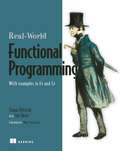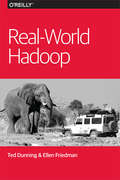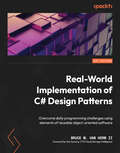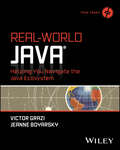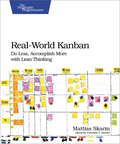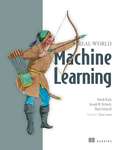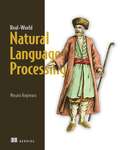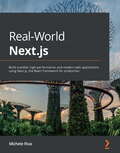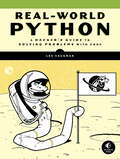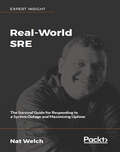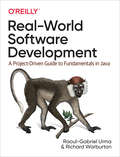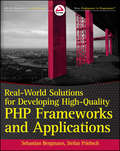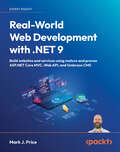- Table View
- List View
Real-World Functional Programming: With examples in F# and C#
by Tomas Petricek Jonathan SkeetFunctional programming languages like F#, Erlang, and Scala are attractingattention as an efficient way to handle the new requirements for programmingmulti-processor and high-availability applications. Microsoft's new F# is a truefunctional language and C# uses functional language features for LINQ andother recent advances.Real-World Functional Programming is a unique tutorial that explores thefunctional programming model through the F# and C# languages. The clearlypresented ideas and examples teach readers how functional programming differsfrom other approaches. It explains how ideas look in F#-a functionallanguage-as well as how they can be successfully used to solve programmingproblems in C#. Readers build on what they know about .NET and learn wherea functional approach makes the most sense and how to apply it effectively inthose cases.The reader should have a good working knowledge of C#. No prior exposure toF# or functional programming is required. Purchase of the print book comes with an offer of a free PDF, ePub, and Kindle eBook from Manning. Also available is all code from the book.
Real-World Hadoop
by Ellen Friedman Ted DunningIf you’re a business team leader, CIO, business analyst, or developer interested in how Apache Hadoop and Apache HBase-related technologies can address problems involving large-scale data in cost-effective ways, this book is for you. Using real-world stories and situations, authors Ted Dunning and Ellen Friedman show Hadoop newcomers and seasoned users alike how NoSQL databases and Hadoop can solve a variety of business and research issues.You’ll learn about early decisions and pre-planning that can make the process easier and more productive. If you’re already using these technologies, you’ll discover ways to gain the full range of benefits possible with Hadoop. While you don’t need a deep technical background to get started, this book does provide expert guidance to help managers, architects, and practitioners succeed with their Hadoop projects.Examine a day in the life of big data: India’s ambitious Aadhaar projectReview tools in the Hadoop ecosystem such as Apache’s Spark, Storm, and Drill to learn how they can help youPick up a collection of technical and strategic tips that have helped others succeed with HadoopLearn from several prototypical Hadoop use cases, based on how organizations have actually applied the technologyExplore real-world stories that reveal how MapR customers combine use cases when putting Hadoop and NoSQL to work, including in production
Real-World Implementation of C# Design Patterns: Overcome daily programming challenges using elements of reusable object-oriented software
by Bruce M. Van Horn II Van SymonsBuild robust applications in C# easily using effective and popular design patterns and best practicesKey FeaturesRecognize solutions to common problems in software design with C#Explore real-world applications of design patterns that can be used in your everyday workGet to grips with 14 patterns and their design implementationsBook DescriptionAs a software developer, you need to learn new languages and simultaneously get familiarized with the programming paradigms and methods of leveraging patterns, as both a communications tool and an advantage when designing well-written, easy-to-maintain code. Design patterns, being a collection of best practices, provide the necessary wisdom to help you overcome common sets of challenges in object-oriented design and programming.This practical guide to design patterns helps C# developers put their programming knowledge to work. The book takes a hands-on approach to introducing patterns and anti-patterns, elaborating on 14 patterns along with their real-world implementations. Throughout the book, you'll understand the implementation of each pattern, as well as find out how to successfully implement those patterns in C# code within the context of a real-world project.By the end of this design patterns book, you'll be able to recognize situations that tempt you to reinvent the wheel, and quickly avoid the time and cost associated with solving common and well-understood problems with battle-tested design patterns.What you will learnGet to grips with patterns, and discover how to conceive and document themExplore common patterns that may come up in your everyday workRecognize common anti-patterns early in the processUse creational patterns to create flexible and robust object structuresEnhance class designs with structural patternsSimplify object interaction and behavior with behavioral patternsWho this book is forThis book is for beginner and mid-level software developers who are looking to take their object-oriented programs or software designing skills to the next level by learning to leverage common patterns. A firm grasp of programming fundamentals and classical object-oriented programming (OOP) using languages like C#, C++, Objective-C, or Java is expected.
Real-World Java: Helping You Navigate the Java Ecosystem (Tech Today)
by Jeanne Boyarsky Victor GraziA concise handbook for the most common tools used in modern Java development Good Java developers learn Java syntax, how to create loops and switches, and can work out a lambda filter stream. But great Java developers need to understand the vast ecosystem of tools and frameworks for collaboration, testing, building, and more. In Real-World Java®: Helping You Navigate the Java Ecosystem, a team of veteran Java developers delivers a concise and authoritative discussion of the most common frameworks, tools, and techniques used in enterprise Java development shops. The authors provide just enough background and examples to allow you to dive right into the expert guidance on annotations, logging frameworks, observability, performance tuning, testing tools, and collaboration, that real-life commercial Java development typically relies on. You’ll expand your Java development toolkit with frameworks and utilities like Spring, Git, Prometheus, and Project Lombok. You’ll also discover links to tested, downloadable code examples that demonstrate the skills discussed in the book. Real-World Java® is the perfect resource for everyone already somewhat comfortable with the language but who wants to familiarize themselves with the tools and frameworks used in contemporary Java software development.
Real-World Kanban: Do Less, Accomplish More with Lean Thinking
by Mattias SkarinYour team is stressed; priorities are unclear. You're not sure what your teammates are working on, and management isn't helping. If your team is struggling with any of these symptoms, these four case studies will guide you to project success. See how Kanban was used to significantly improve time to market and to create a shared focus across marketing, IT, and operations. Each case study comes with illustrations of the Kanban board and diagrams and graphs to help you see behind the scenes.Learn a Lean approach by seeing how Kanban made a difference in four real-world situations. You'll explore how four different teams used Kanban to make paradigm-changing improvements in software development. These teams were struggling with overwork, unclear priorities, and lack of direction. As you discover what worked for them, you'll understand how to make significant changes in real situations.The four case studies in this book explain how to: Improve the full value chain by using Enterprise Kanban Boost engagement, teamwork, and flow in change management and operations Save a derailing project with Kanban Help an office team outside IT keep up with growth using KanbanWhat seems easy in theory can become tangled in practice. Discover why "improving IT" can make you miss your biggest improvement opportunities, and why you should focus on fixing quality and front-end operations before IT. Discover how to keep long-term focus and improve across department borders while dealing with everyday challenges. Find out what happened when using Kanban to find better ways to do work in a well-established company, including running multi-team development without a project office. You'll inspire your team and engage management to make it easier to develop better products.What You Need:This is a case study book, so there are no software requirements. The book covers the relevant bits of theory before presenting the case studies.
Real-World Machine Learning
by Henrik Brink Joseph Richards Mark FetherolfSummary Real-World Machine Learning is a practical guide designed to teach working developers the art of ML project execution. Without overdosing you on academic theory and complex mathematics, it introduces the day-to-day practice of machine learning, preparing you to successfully build and deploy powerful ML systems. Purchase of the print book includes a free eBook in PDF, Kindle, and ePub formats from Manning Publications. About the Technology Machine learning systems help you find valuable insights and patterns in data, which you'd never recognize with traditional methods. In the real world, ML techniques give you a way to identify trends, forecast behavior, and make fact-based recommendations. It's a hot and growing field, and up-to-speed ML developers are in demand. About the Book Real-World Machine Learning will teach you the concepts and techniques you need to be a successful machine learning practitioner without overdosing you on abstract theory and complex mathematics. By working through immediately relevant examples in Python, you'll build skills in data acquisition and modeling, classification, and regression. You'll also explore the most important tasks like model validation, optimization, scalability, and real-time streaming. When you're done, you'll be ready to successfully build, deploy, and maintain your own powerful ML systems. What's Inside Predicting future behavior Performance evaluation and optimization Analyzing sentiment and making recommendations About the Reader No prior machine learning experience assumed. Readers should know Python. About the Authors Henrik Brink, Joseph Richards and Mark Fetherolf are experienced data scientists engaged in the daily practice of machine learning. Table of Contents PART 1: THE MACHINE-LEARNING WORKFLOW What is machine learning? Real-world data Modeling and prediction Model evaluation and optimization Basic feature engineering PART 2: PRACTICAL APPLICATION Example: NYC taxi data Advanced feature engineering Advanced NLP example: movie review sentiment Scaling machine-learning workflows Example: digital display advertising
Real-World Natural Language Processing: Practical applications with deep learning
by Masato HagiwaraReal-world Natural Language Processing shows you how to build the practical NLP applications that are transforming the way humans and computers work together.In Real-world Natural Language Processing you will learn how to: Design, develop, and deploy useful NLP applications Create named entity taggers Build machine translation systems Construct language generation systems and chatbots Use advanced NLP concepts such as attention and transfer learning Real-world Natural Language Processing teaches you how to create practical NLP applications without getting bogged down in complex language theory and the mathematics of deep learning. In this engaging book, you&’ll explore the core tools and techniques required to build a huge range of powerful NLP apps, including chatbots, language detectors, and text classifiers. Purchase of the print book includes a free eBook in PDF, Kindle, and ePub formats from Manning Publications. About the technology Training computers to interpret and generate speech and text is a monumental challenge, and the payoff for reducing labor and improving human/computer interaction is huge! Th e field of Natural Language Processing (NLP) is advancing rapidly, with countless new tools and practices. This unique book offers an innovative collection of NLP techniques with applications in machine translation, voice assistants, text generation, and more. About the book Real-world Natural Language Processing shows you how to build the practical NLP applications that are transforming the way humans and computers work together. Guided by clear explanations of each core NLP topic, you&’ll create many interesting applications including a sentiment analyzer and a chatbot. Along the way, you&’ll use Python and open source libraries like AllenNLP and HuggingFace Transformers to speed up your development process. What's inside Design, develop, and deploy useful NLP applications Create named entity taggers Build machine translation systems Construct language generation systems and chatbots About the reader For Python programmers. No prior machine learning knowledge assumed. About the author Masato Hagiwara received his computer science PhD from Nagoya University in 2009. He has interned at Google and Microsoft Research, and worked at Duolingo as a Senior Machine Learning Engineer. He now runs his own research and consulting company. Table of Contents PART 1 BASICS 1 Introduction to natural language processing 2 Your first NLP application 3 Word and document embeddings 4 Sentence classification 5 Sequential labeling and language modeling PART 2 ADVANCED MODELS 6 Sequence-to-sequence models 7 Convolutional neural networks 8 Attention and Transformer 9 Transfer learning with pretrained language models PART 3 PUTTING INTO PRODUCTION 10 Best practices in developing NLP applications 11 Deploying and serving NLP applications
Real-World Next.js: Build scalable, high-performance, and modern web applications using Next.js, the React framework for production
by Michele RivaLearn how to use Next.js for building web apps without compromising performance, user experience, and developer happinessKey FeaturesDevelop scalable web applications using Next.jsUse Next.js as a frontend for existing backends and e-commerce websites and understand how to implement it with any headless CMSDeploy Next.js on different platforms, such as Vercel, DigitalOcean, and AWS, or on your own serverBook DescriptionNext.js is a scalable and high-performance React.js framework for modern web development and provides a large set of features, such as hybrid rendering, route prefetching, automatic image optimization, and internationalization, out of the box. If you are looking to create a blog, an e-commerce website, or a simple website, this book will show you how you can use the multipurpose Next.js framework to create an impressive user experience.Starting with the basics of Next.js, the book demonstrates how the framework can help you reach your development goals. You'll realize how versatile Next.js is as you build real-world applications with step-by-step explanations. This Next.js book will guide you in choosing the right rendering methodology for your website, securing it, and deploying it to different providers, all while focusing on performance and developer happiness.By the end of the book, you'll be able to design, build, and deploy modern architectures using Next.js with any headless CMS or data source.What you will learnGet up to speed with Next.js essentials and learn how to build apps quicklyUnderstand how to create scalable Next.js architecturesChoose between different rendering strategies, such as client-side rendering (CSR), static site generation (SSG), server-side rendering (SSR), and incremental static regeneration (ISR)Write unit tests and integration tests in your Next.js applicationDiscover the powerful routing system and Next.js' built-in componentsDesign and build modern architectures with Next.js using GraphCMS or any headless CMSWho this book is forThis book is for web developers who want to improve their React skills by building scalable and maintainable full-stack applications using the modern Next.js web framework. Intermediate-level knowledge of ES6+, React, Node.js, and REST is assumed.
Real-World Python: A Hacker's Guide to Solving Problems with Code
by Lee VaughanA project-based approach to learning Python programming for beginners. Intriguing projects teach you how to tackle challenging problems with code.You've mastered the basics. Now you're ready to explore some of Python's more powerful tools. Real-World Python will show you how.Through a series of hands-on projects, you'll investigate and solve real-world problems using sophisticated computer vision, machine learning, data analysis, and language processing tools. You'll be introduced to important modules like OpenCV, NumPy, Pandas, NLTK, Bokeh, Beautiful Soup, Requests, HoloViews, Tkinter, turtle, matplotlib, and more. You'll create complete, working programs and think through intriguing projects that show you how to:Save shipwrecked sailors with an algorithm designed to prove the existence of GodDetect asteroids and comets moving against a starfieldProgram a sentry gun to shoot your enemies and spare your friendsSelect landing sites for a Mars probe using real NASA mapsSend unbreakable messages based on a book codeSurvive a zombie outbreak using data scienceDiscover exoplanets and alien megastructures orbiting distant starsTest the hypothesis that we're all living in a computer simulationAnd more!If you're tired of learning the bare essentials of Python Programming with isolated snippets of code, you'll relish the relevant and geeky fun of Real-World Python!
Real-World SRE: The Survival Guide for Responding to a System Outage and Maximizing Uptime
by Nat WelchThis hands-on survival manual will give you the tools to confidently prepare for and respond to a system outage. Key Features Proven methods for keeping your website running A survival guide for incident response Written by an ex-Google SRE expert Book Description Real-World SRE is the go-to survival guide for the software developer in the middle of catastrophic website failure. Site Reliability Engineering (SRE) has emerged on the frontline as businesses strive to maximize uptime. This book is a step-by-step framework to follow when your website is down and the countdown is on to fix it. Nat Welch has battle-hardened experience in reliability engineering at some of the biggest outage-sensitive companies on the internet. Arm yourself with his tried-and-tested methods for monitoring modern web services, setting up alerts, and evaluating your incident response. Real-World SRE goes beyond just reacting to disaster—uncover the tools and strategies needed to safely test and release software, plan for long-term growth, and foresee future bottlenecks. Real-World SRE gives you the capability to set up your own robust plan of action to see you through a company-wide website crisis. The final chapter of Real-World SRE is dedicated to acing SRE interviews, either in getting a first job or a valued promotion. What you will learn Monitor for approaching catastrophic failure Alert your team to an outage emergency Dissect your incident response strategies Test automation tools and build your own software Predict bottlenecks and fight for user experience Eliminate the competition in an SRE interview Who this book is for Real-World SRE is aimed at software developers facing a website crisis, or who want to improve the reliability of their company's software. Newcomers to Site Reliability Engineering looking to succeed at interview will also find this invaluable.
Real-World Software Development: A Project-Driven Guide to Fundamentals in Java
by Richard Warburton Raoul-Gabriel UrmaExplore the latest Java-based software development techniques and methodologies through the project-based approach in this practical guide. Unlike books that use abstract examples and lots of theory, Real-World Software Development shows you how to develop several relevant projects while learning best practices along the way.With this engaging approach, junior developers capable of writing basic Java code will learn about state-of-the-art software development practices for building modern, robust and maintainable Java software. You’ll work with many different software development topics that are often excluded from software develop how-to references.Featuring real-world examples, this book teaches you techniques and methodologies for functional programming, automated testing, security, architecture, and distributed systems.
Real-World Solutions for Developing High-Quality PHP Frameworks and Applications
by Sebastian Bergmann Stefan PriebschLearn to develop high-quality applications and frameworks in PHPPacked with in-depth information and step-by-step guidance, this book escorts you through the process of creating, maintaining and extending sustainable software of high quality with PHP. World-renowned PHP experts present real-world case studies for developing high-quality applications and frameworks in PHP that can easily be adapted to changing business requirements. . They offer different approaches to solving typical development and quality assurance problems that every developer needs to know and master.Details the process for creating high-quality PHP frameworks and applications that can easily be adapted to changing business requirementsCovers the planning, execution, and automation of tests for the different layers and tiers of a Web applicationDemonstrates how to establish a successful development processShares real-world case studies from well-known companies and their PHP expertsWith this book, you'll learn to develop high-quality PHP frameworks and applications that can easily be maintained with reasonable cost and effort.
Real-World Web Development with .NET 9: Build websites and services using mature and proven ASP.NET Core MVC, Web API, and Umbraco CMS
by Mark J. PriceA practical guide for building websites and services with mature and proven ASP.NET Core controller-based technologies.Key FeaturesMaster ASP.NET Core MVC, Web API, and OData for building robust web services.Get hands-on experience with web testing, security, and containerization techniques.Learn how to implement Umbraco CMS for content management websites.Book DescriptionReal-World Web Development with .NET 9 equips you to build professional websites and services using proven technologies like ASP.NET Core MVC, Web API, and OData—trusted by organizations for delivering robust web applications. You’ll learn to design and build efficient web applications with ASP.NET Core MVC, creating well-structured, maintainable code that follows industry best practices. From there, you'll dive into Web API, mastering how to build RESTful services that are both secure and scalable. Along the way, you’ll also explore testing, authentication, containerization for deployment, ensuring that your solutions are fully production-ready. In the final part of the book, you will be introduced to Umbraco CMS, a popular content management system for .NET. By mastering this tool, you’ll learn how to empower users to manage website content independently. By the end of this book, you'll not only have a solid grasp of controller-based development but also the practical know-how to build dynamic, content-driven websites using a popular .NET CMS.What you will learnBuild web applications using ASP.NET Core MVC with well-structured, maintainable codeDevelop secure and scalable RESTful services using Web API and ODataImplement authentication and authorization for your applicationsTest and containerize your .NET projects for smooth deploymentOptimize application performance with caching and other techniquesLearn how to use and implement Umbraco CMSWho this book is forThis book is aimed at intermediate .NET developers with a good understanding of C# and .NET fundamentals. It is ideal for developers looking to expand their skills in building professional, controller-based web applications.
Real-World Wireless Sensor Networks
by Luca Mottola Koen Langendoen Wen Hu Federico Ferrari Marco ZimmerlingThis edited book presents the results of the 5th Workshop on Real-world Wireless Sensor Networks (REALWSN). The purpose of this workshop was to bring together researchers and practitioners working in the area of sensor networks, with focus on real-world experiments or deployments of wireless sensor networks. Included were, nonetheless, emerging forms of sensing such as those that leverage smart phones, Internet of Things, RFIDs, and robots. Indeed, when working with real-world experiments or deployments, many new or unforeseen issues may arise: the network environment may be composed of a variety of different technologies, leading to very heterogeneous network structures; software development for large scale networks poses new types of problems; the performance of prototype networks may differ significantly from the deployed system; whereas actual sensor network deployments may need a complex combination of autonomous and manual configuration. Furthermore, results obtained through simulation are typically not directly applicable to operational networks; it is therefore imperative for the community to produce results from experimental research. The workshop collected the state of the art in emerging and current research trends dealing with Real-world Wireless Sensor Networks, with the aim of representing a stepping stone for future research in this field.
Real-time 3D Character Animation with Visual C++
by Nik LeverDo you have some experience and a reasonable knowledge of C++ and want to write your own computer games? Have you ever looked at a PC or Playstation (R) game with characters running and leaping through an exciting landscape and wondered how it was done? If so then this book will give you all the information you need to achieve this goal, whether you are a hobby programmer, student or even a professional wanting to add that third dimension to your website.Nik Lever takes you through the journey from the basics of 3D manipulation all the way to morph objects and sub-division surfaces. On the way you get Visual C++ project files to study and software that runs on the Windows desktop. The free CD-ROM gives you a full-featured development environment for 3D character animation, so even if you find some of the maths and the code hard to follow straight away you can still create your own games. The game engine (Toon3DCreator) provided free and fully functional on the CD-ROM, even has an ActiveX control that allows you to distribute your work on the Internet. All source code for Toon3D is included on the CD. You will also get an insight into the artist's problems; learn how to keep the characters interesting while not exhausting the game engine. Understand the complete picture and make the most of your skills to help you succeed in, or break into the computer gaming industry with this comprehensive guide to programming for real-time 3D character animation.
Real-time Analytics with Storm and Cassandra
by Shilpi SaxenaIf you want to efficiently use Storm and Cassandra together and excel at developing production-grade, distributed real-time applications, then this book is for you. No prior knowledge of using Storm and Cassandra together is necessary. However, a background in Java is expected.
Real-time Communication Protocols for Multi-hop Ad-hoc Networks: Wireless Networking in Production and Control Systems (Computer Communications and Networks)
by Reinhard GotzheinThis book focuses on core functionalities for wireless real-time multi-hop networking with TDMA (time-division multiple access) and their integration into a flexible, versatile, fully operational, self-contained communication system. The use of wireless real-time communication technologies for the flexible networking of sensors, actuators, and controllers is a crucial building block for future production and control systems. WirelessHART and ISA 100.11a, two technologies that have been developed predominantly for industrial use, are currently available. However, a closer analysis of these approaches reveals certain deficits. Current research on wireless real-time communication systems shows potential to remove these limitations, resulting in flexible, versatile, and robust solutions that can be implemented on today’s low-cost and resource-constrained hardware platforms. Unlike other books on wireless communication, this book presents protocols located on MAC layer and above, and build on the physical (PHY) layer of standard wireless communication technologies.
Real-time Knowledge-based Fuzzy Logic Model for Soft Tissue Deformation (Studies in Computational Intelligence #832)
by Amandeep S. Sidhu Joey Sing TanThis book provides a real-time and knowledge-based fuzzy logic model for soft tissue deformation. The demand for surgical simulation continues to grow, as there is a major bottleneck in surgical simulation designation and every patient is unique. Deformable models, the core of surgical simulation, play a crucial role in surgical simulation designation. Accordingly, this book (1) presents an improved mass spring model to simulate soft tissue deformation for surgery simulation; (2) ensures the accuracy of simulation by redesigning the underlying Mass Spring Model (MSM) for liver deformation, using three different fuzzy knowledge-based approaches to determine the parameters of the MSM; (3) demonstrates how data in Central Processing Unit (CPU) memory can be structured to allow coalescing according to a set of Graphical Processing Unit (GPU)-dependent alignment rules; and (4) implements heterogeneous parallel programming for the distribution of grid threats for Computer Unified Device Architecture (CUDA)-based GPU computing.
Real-time Monitoring and Operational Control of Drinking-Water Systems
by Vicenç Puig Carlos Ocampo-Martínez Ramon Pérez Gabriela Cembrano Joseba Quevedo Teresa EscobetThis book presents a set of approaches for the real-time monitoring and control of drinking-water networks based on advanced information and communication technologies. It shows the reader how to achieve significant improvements in efficiency in terms of water use, energy consumption, water loss minimization, and water quality guarantees. The methods and approaches presented are illustrated and have been applied using real-life pilot demonstrations based on the drinking-water network in Barcelona, Spain. The proposed approaches and tools cover: * decision-making support for real-time optimal control of water transport networks, explaining how stochastic model predictive control algorithms that take explicit account of uncertainties associated with energy prices and real demand allow the main flow and pressure actuators--pumping stations and pressure regulation valves-- and intermediate storage tanks to be operated to meet demand using the most sustainable types of source and with minimum electricity costs; * decision-making support for monitoring water balance and distribution network quality in real time, implementing fault detection and diagnosis techniques and using information from hundreds of flow, pressure, and water-quality sensors together with hydraulic and quality-parameter-evolution models to detect and locate leaks in the network, possible breaches in water quality, and failures in sensors and/or actuators; * consumer-demand prediction, based on smart metering techniques, producing detailed analyses and forecasts of consumption patterns, providing a customer communications service, and suggesting economic measures intended to promote more efficient use of water at the household level. Researchers and engineers working with drinking-water networks will find this a vital support in overcoming the problems associated with increased population, environmental sensitivities and regulation, aging infrastructures, energy requirements, and limited water sources.
Real-time Security Extensions for EPCglobal Networks: Case Study for the Pharmaceutical Industry
by Matthieu-P. SchapranowThe transformation towards EPCglobal networks requires technical equipment for capturing event data and IT systems to store and exchange them with supply chain participants. For the very first time, supply chain participants thus need to face the automatic exchange of event data with business partners. Data protection of sensitive business secrets is therefore the major aspect that needs to be clarified before companies will start to adopt EPCglobal networks. This book contributes to this proposition as follows: it defines the design of transparent real-time security extensions for EPCglobal networks based on in-memory technology. For that, it defines authentication protocols for devices with low computational resources, such as passive RFID tags, and evaluates their applicability. Furthermore, it outlines all steps for implementing history-based access control for EPCglobal software components, which enables a continuous control of access based on the real-time analysis of the complete query history and a fine-grained filtering of event data. The applicability of these innovative data protection mechanisms is underlined by their exemplary integration in the FOSSTRAK architecture.
Real-time Speech and Music Classification by Large Audio Feature Space Extraction
by Florian EybenThis book reports on an outstanding thesis thathas significantly advanced the state-of-the-art in the automated analysis andclassification of speech and music. Itdefines several standard acoustic parameter sets and describes theirimplementation in a novel, open-source, audio analysis framework calledopenSMILE, which has been accepted and intensively used worldwide. The bookoffers extensive descriptions of key methods for the automatic classificationof speech and music signals in real-life conditions and reports on theevaluation of the framework developed and the acoustic parameter sets that wereselected. It is not only intended as a manual for openSMILE users, but also andprimarily as a guide and source of inspiration for students and scientists involvedin the design of speech and music analysis methods that can robustly handlereal-life conditions.
Real-time Strategy and Business Intelligence
by Marko KohtamäkiThis book discusses and conceptualizes practices on real-time strategy, focusing on the interplay between strategy and business intelligence. Combining strategic practices and business intelligence systems, the authors demonstrate how managerial practices can be developed in the age of digitization. Also developing the concept of strategic agility, the book provides perspectives from a range of disciplines including strategic practices and decision making, customer relationship management, human resource management, competitive intelligence, supplier network management and business intelligence systems. Presenting managerial frameworks and guidelines, Real-time Strategy and Business Intelligence explores how to improve utilization of business intelligence systems in real-time decision making. Providing practical and future-oriented insights backed by examples and best practices, the authors present a clearly conceptualized theoretical framework.
Real-time Systems
by Jane W. S. LiuWritten by a renowned authority, this advanced text comprehensively covers the advances in real-time operating systems and communications networks, emphasizing research results that have been adopted in state-of-the-art systems.
Real-time Systems Scheduling 1: Fundamentals
by Maryline ChettoReal-time systems are used in a wide range of applications, including control, sensing, multimedia, etc. Scheduling is a central problem for these computing/communication systems since responsible of software execution in a timely manner. This book provides state of knowledge in this domain with special emphasis on the key results obtained within the last decade. This book addresses foundations as well as the latest advances and findings in Real-Time Scheduling, giving all references to important papers. But nevertheless the chapters will be short and not overloaded with confusing details. Coverage includes scheduling approaches for mono-core as well as multi-core platforms, dependent tasks, networks, and notably very tremendous recent advances in scheduling of energy constrained embedded systems. Other sophisticated issues such as feedback control scheduling and timing analysis of critical applications are also addressed. This volume can serve as a textbook for courses on the topic in bachelor and in more advanced master programs. It also provides a reference for computer scientists and engineers involved in the design or the development of Cyber-Physical Systems which require up-to-date real-time scheduling solutions.
Real-time Systems Scheduling 2
by Maryline ChettoReal-time systems are used in a wide range of applications, including control, sensing, multimedia, etc. Scheduling is a central problem for these computing/communication systems since it is responsible for software execution in a timely manner. This book, the second of two volumes on the subject, brings together knowledge on specific topics and discusses the recent advances for some of them. It addresses foundations as well as the latest advances and findings in real-time scheduling, giving comprehensive references to important papers, but the chapters are short and not overloaded with confusing details. Coverage includes scheduling approaches for networks and for energy autonomous systems. Other sophisticated issues, such as feedback control scheduling and probabilistic scheduling, are also addressed.This book can serve as a textbook for courses on the topic in bachelor's degrees and in more advanced master's degree programs. It also provides a reference for computer scientists and engineers involved in the design or the development of Cyber-Physical Systems which require up-to-date real-time scheduling solutions.
